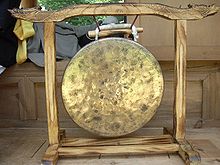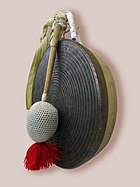Jing (gong)
| Korean spelling | |
|---|---|
| Korean alphabet : | 징 |
| Revised Romanization : | Jing |
| McCune-Reischauer : | Ching |
Jing ( Korean : 징 ) is a medium-sized and flat Korean gong that is gently struck with a cloth-covered mallet to generate sound . The jing was used by farmers , Buddhists , shamans, and in military music , and it may come today. a. still used in performances such as pungmulnori ( 풍물 놀이 ), dance and song with four percussion instruments and samulnori ( 사물 놀이 ), drums with four instruments.
Design
The Jing is made of high quality sheet metal and is made from one piece. The material used was formerly bronze , today also brass . Jing, which were previously used by farmers, were usually 37 to 38 cm in diameter, up to 8 cm high and were held by one hand while hanging on a handle loop. The jing played by shamans was slightly smaller and those used in court ceremonies were slightly larger in diameter. The form of jing, which is more commonly used today, is held by one hand. Other versions are hanging in a wooden stand. The Jing includes a mallet about 30 cm long and 2.5 cm thick, which has a padded head with a diameter of about 8 cm at the striking end.
Style of play
Whether held by hand or fixed in a wooden frame, the gong is struck with the mallet at longer intervals than is the case with a drum. After the hit, a lingering tone develops which, depending on the intensity of the hit, creates a reverberation of different lengths . The reverberation of the note makes a fast beat number impossible. The sound produced contains three acoustic wave movements, which in Korea is called sam-pa-eum ( 삼 파 음 ) ("three-wave sound").
The role of a jing in a performance lies on the one hand in the timing and / or has the function of complementing the piece with its differentiated timbre and long resonance, resonant tone. In a Samulnori performance, the jing sets the rhythm.
Another form of name
The jing used in a royal ritual sacrifice ceremony was previously known as daegeum ( 대금 ). A jing with a diameter of 36 to 40 cm, hanging freely in a wooden frame, was popularly called gwangmaegi ( 광 매기 ).
literature
- Byong-Won Lee, Yong-Shik Lee : Music of Korea . In: National Center for Korean Traditional Performing Arts (Ed.): Korean Musicology . Series 1 . Seoul 2007, Folk Music: Instrumental (English).
- Keith Howard : Korean Musical Instruments . Oxford University Press , Oxford 1995, ISBN 0-19-586177-9 (English).
Individual evidence
- ↑ a b c Traditional Instruments - Jing . Korea Tourism Organization , accessed January 9, 2013 .
- ^ B. Lee, Y. Lee : Music of Korea . 2007, p. 96 .
- ↑ a b National Center for Korean Traditional Performing Arts (Ed.): Theoretical Perspectives on Korean Traditional Music . Seoul 2002, Idiophones - Jing - paleum: metal (English, online PDF 146 kB [accessed on January 9, 2013]).
- ^ Andre Eckardt: Music - Song - Dance in Korea . H. Bouvier & Co., Bonn 1968, p. 45 .

